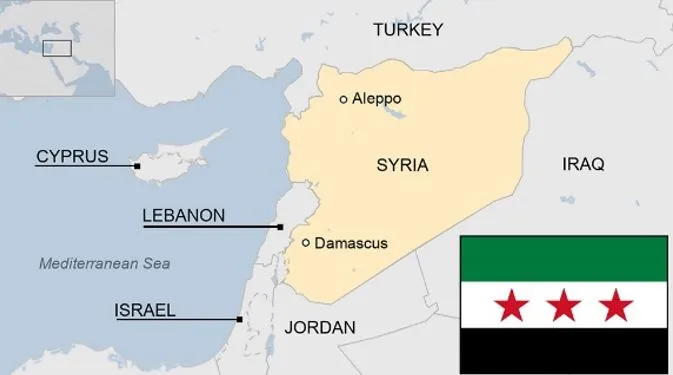

17th May 2025 (9 Topics)
Context
US President Donald Trump visited Saudi Arabia, Qatar, and the UAE, where he announced the lifting of 46-year-old US sanctions on Syria. This marked a dramatic policy shift, especially since Syria's new leader, Ahmed al-Sharaa, is a former al-Qaeda affiliate once targeted by the US.
Brief Background
- The US imposed sanctions on Syria in 1979 after it was designated a State Sponsor of Terrorism, especially for supporting Palestinian and Lebanese armed groups.
- These sanctions intensified over the years:
-
- 2004: Added economic and defense restrictions.
- 2011–2019: After Syria’s civil war began, sanctions became comprehensive, targeting oil, finance, and state-linked individuals (like Assad) under the Caesar Act.
- Now, Trump plans to revoke most of these, starting with those under executive orders.
Why the US is Changing Course on Syria?
- Change of Leadership Justifies Policy Shift: The primary reason Trump could justify lifting sanctions is that Bashar al-Assad has been removed. Since US sanctions were tied to Assad’s regime—due to human rights abuses, war crimes, and support to terrorist groups—the exit of Assad provides a technical and symbolic opening.
- Al-Sharaa, who led a coalition that ousted Assad, now heads a “transitional administration”.
- Though his past links with al-Qaeda are serious, Trump has decided to ignore this history, focusing instead on realpolitik and “regional ownership” of stability.
- Moderation & Stability in Syria: Al-Sharaa’s government is being presented as more moderate and pragmatic:
- He has unified sectarian militias, integrated them into the national military, and avoided overt ideological posturing.
- He is also open to international cooperation, including potentially recognizing Israel through the Abraham Accords and working to suppress ISIS.
- This makes it easier for the US and allies to engage Syria— sanctions have done their job in pushing out Assad and creating space for a relatively stable government.
What is US’s Middle East Vision?
- Shift from Military to Economic Engagement: Trump’s approach in the Middle East is less about democracy promotion or military intervention, and more about economic deals. He emphasized “regionally-owned” conflict resolution, signaling US disengagement from ground conflicts like Syria and Iraq. Instead of promising aid or military presence, he wants:
- Syria to handle its own reconstruction (with help from Gulf states).
- Al-Sharaa to assist in containing ISIS and policing extremist groups.
- Massive Trade Deals with Gulf States: Trump's visit produced USD 1 trillion in combined deals:
- USD 600 billion with Saudi Arabia, including a record USD 142 billion arms deal.
- USD 243.5 billion with Qatar.
- USD 200 billion with the UAE.
- In return, the Gulf states are:
- Investing in the US economy.
- Offering Trump personal favors (e.g., Qatar gifting a custom Air Force One jet, real estate deals).
- Engaging with key Trump allies, like Elon Musk, who is helping Saudi Arabia integrate Starlink for digital expansion.
- Emerging Minilateralism: Trump continues to push for groupings like the I2U2 (India-Israel-UAE-USA) which emphasise economic and technological collaboration rather than military alignment.
- His call for Syria to join the Abraham Accords may be part of a larger effort to reshape regional alliances into more transactional, economically-driven platforms.

What about Israel?
- Israel’s Discomfort: Israel, under Prime Minister Netanyahu, opposes lifting sanctions on Syria, viewing it as empowering a potential threat near its border. It also worries about US re-engagement with Turkey and Iran.
- Turkey is being allowed back into the F-35 fighter jet program (after being removed for buying Russian weapons).
- The US recently approved a USD 304 million missile deal with Ankara.
- Talks with Iran: Most controversially, Trump said the US and Iran are close to a new nuclear deal. Iran appears ready to trade its enriched uranium stockpile in exchange for sanctions relief. The Houthis, an Iran-backed militia in Yemen, have also gained leverage. The US halted airstrikes in exchange for reduced attacks on American shipping.
- Israel, however, remains skeptical and has stated it will defend itself alone if needed, especially against continued Houthi attacks.
Implications for India
- Opportunities in Connectivity and Investment: India can benefit from the renewed US-Gulf engagement by participating in projects like:
-
- IMEC (India-Middle East-Europe Economic Corridor) — this could boost India's trade, energy access, and regional connectivity.
- Collaborative projects in defence technology, logistics, and infrastructure.
- Reinforcement of India-Gulf Ties: Gulf nations like UAE and Saudi Arabia are becoming more important to India — not just as energy suppliers and labour markets, but also as strategic partners. Trump's push for Gulf diversification aligns well with India's "Act West" policy.
- Caution Required on Third-Party Mediation: Trump claimed credit for "defusing India-Pakistan tensions" through trade diplomacy — a statement that India finds uncomfortable, given its long-standing opposition to external mediation on Kashmir.
- Furthermore, Saudi Arabia’s occasional offers to mediate between India and Pakistan may become more prominent under this new West Asia dynamic, which India will need to handle delicately.
- Navigating Ethical Grey Zones : Trump’s blending of political office with private business could lead to unpredictable policy shifts. India must be cautious while entering any trilateral or multilateral economic deals where personal interests might influence American diplomacy.
More Articles

